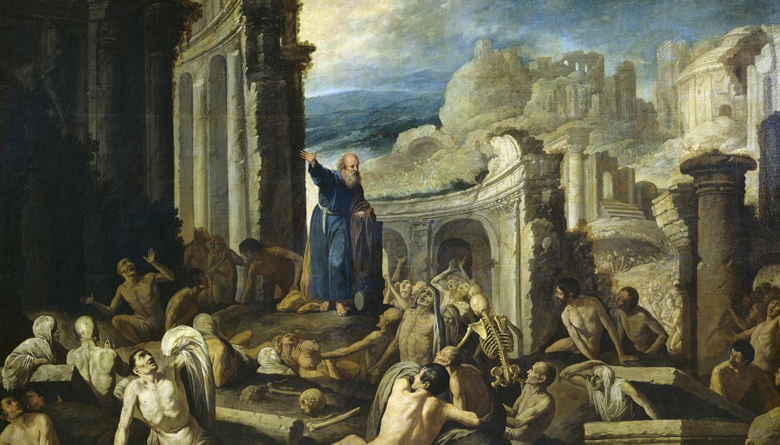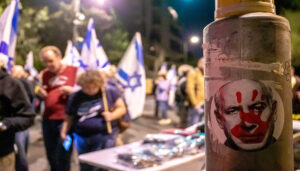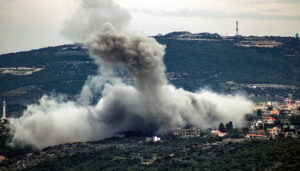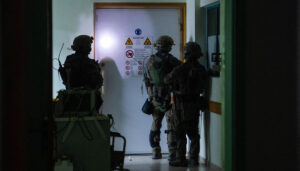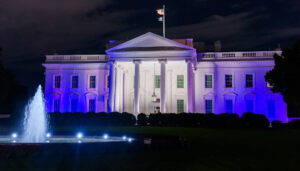BY: yazan loujami
“To the boisterous accompaniment of fireworks, dancers, laser beams, politics and controversy, the city of Jerusalem today began a 15-month celebration of the 3,000 years since King David wrested the hilltop town from the Jebusites and proclaimed it the capital of the Jewish people.”
This is how New York Times described the 1995 celebrations attended by Israeli officials and war criminals, presided by Prime Minister Yitzhak Rabin who was directly involved in atrocities such as the 1948 ethnic cleansing of Lydda and the 1967 occupation of Arab territories, including East Jerusalem. For the occasion, a musical work was commissioned to Polish composer Krzysztof Penderecki (1931- ), a major figure of the contemporary classical scene.
In the 1950s, Penderecki was part of the postwar avant-garde generation, experimenting with innovative sonorities and new graphic methods of notation. He later described this phase as one “of juvenile revolt, where we thought that through art, we could change the world order.” By the 1990s, he had reverted to a more traditional tone influenced by romantic and baroque music. He also began drawing upon religious texts in his compositions, especially the Bible.
The commissioned work was titled “Seven Gates of Jerusalem,” and came in seven movements symbolizing each of the mythical gates. Originally conceived as an oratorio, a musical form typically reserved for religious compositions, the work was written for choir and orchestra. In order to add yet another layer of numerology to the piece, Penderecki later decided to call it a symphony, bestowing it with the additional title of “Symphony No. 7.”
The symphony was not intended to celebrate Jerusalem as a whole, though. The portions of text selected as inspiration for the piece were exclusively from the Old Testament, and referred to the idea that the establishment of Israel is the divine right of the Jewish people. Although these emotionally-charged excerpts appear at first glance to form an exemplary Zionist collage tailored for propaganda purposes, they are more complex upon further examination.
When it comes to the “Holy Land,” especially Jerusalem, Penderecki remains one of many who still consider The Scriptures as the first and absolute authority on the topic. In this view, the Scriptures are seen as containing all there is to be said about the Holy Land at any given occasion in history. This shortcut transcends contemporary considerations such as the First Intifada, which only ended a couple years before the composition of the piece, or the city’s oppressed Palestinian natives, who only exist to the extent that the margins of the biblical narrative allow them to.
The symphony opens with an alarming, brassy blow. The choir steps in with a recitation of Psalm 48, majestically styled after Russian Orthodox chanting: “Great is the Lord, and most worthy of praise, in the city of our God.” This is followed by lamenting solo singers (2:40), this time evoking Bach’s Passions. The movement demonstrates Penderecki’s famous skill of bringing together different styles: protestant chorales, Orthodox hymns, and grandiose 19th century Catholic masses and requiems. These influences, despite their diversity, remain within the Western tradition. As for the symphony’s language, Latin was the obvious choice, it being the ideal expression of Western appropriation of the Gospel. Further, the use of Latin serves as a powerful ceremonial tool that relies on inspiring awe rather than communicating content.
The second and fourth movements are based on Psalm 137, where exiled Hebrews in Babylon lament their lost city.
These are accompanied by a theme of seven repeated notes, first played by bass instruments, which then rises to a cacophony of piercing brass instruments. Even in the context of a supposed celebration, the poetics of this Jerusalem are based on lamentation and the rote recreation of the pathos from ancient stories, such as that of the Babylonian exile. This tragedy, despite being over one thousand years old, remains more relatable and worthy of tribute than the contemporary and uncannily similar tragedy right next door. The exile of millions of Palestinians and their towns being slowly obliterated is tragic, but it will never have the biblical backing to be poetic or relevant enough to Penderecki and his peers. This truth remains one of the darkest ironies of Penderecki’s symphony.
After the fifth movement, where Psalm 147 is chanted against the war-like beat of drums, recalling works of Stravinsky, Penderecki performs a real tour de force with the breathtaking sixth movement. Victorious “Alleluias” suddenly collapse into chaos, sweeping us into an otherworldly place where time is suspended, and a voice starts narrating the story from Ezekiel 37 known as the “Vision of the Valley of Dry Bones.”
The storytelling shifts to biblical Hebrew, another dead language whose charming ceremonial power is intensified by an eerie timeless background. This corresponds to the eternal character of Penderecki’s Jerusalem, as well as to the dreamlike story where Yahweh brings dead bones back to life before the prophet’s eyes, telling him that these are “the entire house of Israel” that he will bring back from exile.
The orchestra brilliantly highlights the text, with the word “rokh” (spirit) occasionally pronounced over bowed cymbals and violins on high octaves, creating a fragile luminous sound like a breath of life, while clattering percussion evokes the sound of dry bones. When the orchestra reaches the point in the narrative where the bodies are resurrected, a faint heartbeat is heard, rising ominously, tearing the vision away and bringing us back into the symphony’s normal timeline.
If contemporary classical music is constantly stigmatized for being too experimental, then Penderecki’s conservative Symphony No. 7 stands as an ironic exception. The work proves again with its pompous monumentality that Jerusalem is only meant to be experienced through the collective and the ceremonial. By celebrating his petrified Western ideal of the city, clear of Palestinian traces, Muslim or Christian, Penderecki was certainly not making a political statement. He was not even making a conscious choice for that matter, because when it comes to Jerusalem, a set of choices are already made for him through centuries of art and liturgical music. From Monteverdi to Messiaen, composers have always promoted the sheer power of the mythical city, effectively overshadowing the real one. This is the reason why Penderecki’s symphony rang as business as usual, even repetitive, to western listeners. But it is not, and that is the danger of it.
The difference is that older works have always been written for liturgical use, where the ambiguity between the celestial, the biblical, and the actual Jerusalem remained relatively harmless. But by automatically carrying that tradition outside the abstract realm of the Church, and into the physical city itself, the gap was rendered too explicit, and a horrifying statement was made. It harmonized perfectly with Israel’s official discourse; a symphony whose only relation to this part of earth (very much like Israel itself) is an ancient assembly of texts, torn away from its complicated context and saturated with centuries of Western projections.
In a speech he gave at the University of Glasgow in 1995, Penderecki explained his choice of text as “a return to the roots of the Judeo-Christian culture, a return to the origin of music,” describing the psalms as “the archetypal model of our culture.” However, it should have been clear by the 1990s that such conventions made in the West do not relate to the present (or historical) reality of the city. If anything, they only contribute to a mass of power relations and military forces that work to further alienate Palestinians by expropriating their city, destroying it, replacing its street names with neo-biblical ones, and then replacing its people altogether.
If the dogmatism of works like Penderecki’s symphony does not oppress listeners with its violence, then neither will the concept of Israel, which will continue to seem as natural as an old fresco finally getting restored, removing parasitic layers and filling in occasional gaps. The extent to which Penderecki was aware of this does not matter. When Rabin opened the ceremony stating that Jerusalem is “the capital of the state of Israel,” Penderecki’s symphony could not help but offer a compliant nod of agreement, a soundtrack to the spectacle of horrors that has been tearing the region further apart since the Balfour Declaration. “Ingrediatur gens justa, custodians veritatem,” says the symphony. As for the Palestinians, they can go to hell.
